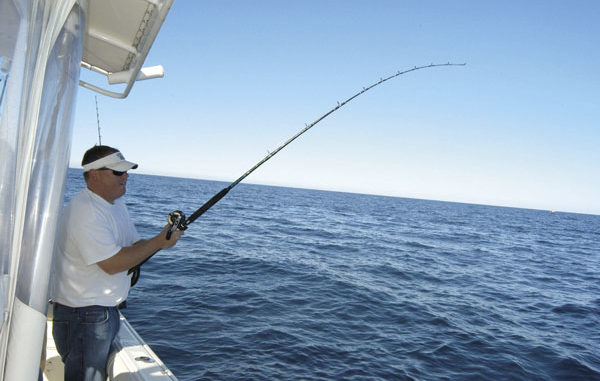
The big move inshore takes place this month; here’s how to boat a border mackerel.
As Labor Day approaches, a lot of sportsmen turn their attention, at least momentarily, to thoughts of dove shoots and Thermacell and bucks in velvet.
Not David Cutler. Although he’s got a hunting background — Ducks, beware! — when September appears on the horizon, he sets his cap for the king mackerel that call the waters off Little River home. And it hasn’t taken him long to recognize September as the gateway to fall fishing in the area around the North Carolina/South Carolina border.
“You start to see bigger kings start pushing in toward the beach and starting to feed,” said Cutler, who runs Lowcountry Fishing Charters out of Little River. “As we get some cooler evenings, the water starts to get a little cooler. As soon as the water temperature starts down under 80 degrees, you see an explosion of life off our coast. We should see plenty of big fish this year.”
For much of the year when he targets kings, Cutler (843-222-7433) has a fairly long run to the fishing grounds. A ledge approximately 20 miles out of Little River features a handful of places where kings spend much of the summer: the 65-Foot Hole, the Jungle, the Shark Hole.
“That ledge tends to hold fish pretty well all summer,” Cutler said. “They can be anywhere along that ledge, and if I want to catch fish consistently, I’ll fish that 65-foot ledge. If I’m looking for big fish, I’ll be off the beach, wherever I can find bait — around the inlets and the tidelines.
“I’ll start September out there, but as the month progresses and the water gets cooler, all the big fish will push in inside of five miles off the beach. When we start getting some cooler nights, they’ll feel the fall coming and start feeding to fatten up for the winter.”
When he thinks the kings are making a big move toward the beach, Cutler fishes a series of reefs, wrecks and livebottom closer in.
“I’ll go fish a spot and see if the fish have started to show up in more consistent numbers,” he said. “The Sherman (reef) will hold kings, there is a lot of livebottom that will concentrate them: the 410/510, the 390/390, Christina’s Ledge. We’ll even run 30 miles or so to fish the Yaupon Reef (an artificial reef outside the mouth of North Carolina’s Cape Fear River). You fish ledges, livebottom, any kind of structure.
Finally, in the back half of the month, kings will make their big move to the beach, where huge concentrations of bait will hang out until late in the fall when water temperatures finally drive them away.
At that point, Cutler follows concentrations of bait up and down the beach, often extremely close to the shoreline.
“The closer you get to October, the more you fish the tidelines outside the inlets, and you fish bait balls, you work inshore structure like the 1-mile reef and the 3-mile reef,” Cutler said. “You need to be conscious of the tide and fish them on a falling or low tide.
“There are some deep holes off the ends of some of the piers, and there are little rockpiles all along the beach — any little thing that might be something for bait and kings to hang around. Bait is mostly what you’re looking for. As the fall progresses, we’ll get more and more concentrations of bait right off the beach.”
Little River isn’t the only inlet around which baitfish and kings will concentrate. Cutler will fish Hog Inlet, about three miles south of Little River, and he’ll fish the three inlets in North Carolina that are closest to the state line: Tubbs Inlet, Shallotte Inlet and Lockwood Folly Inlet. Any of those four, plus Little River, can become as hot as a firecracker if a big concentration of bait moves in, because the big kings will follow.
Cutler fishes a spread of four to five rods behind his 27-foot Sailfish center console. He drifts and slow-trolls using standard live-bait rigs, preferring live menhaden but not shying away from using dead cigar minnows — a charter captain’s staple.
“I like to fish one bait right on the bottom on a downrigger, then one right around the thermocline (the “imaginary” line where heavier, cooler water deep in the water column meets warmer, more-oxygenated water closer to the surface),” he said. “I’ll keep two baits on top, and I’ll fish another one right in the prop wash.”
Cutler fishes live bait and cigar minnows with or without colorful skirts until he gets a sense of what kings are interested in on a particular day.
“I’ll change up a lot,” he said. “We’ll offer them something different to look at, put out different baits in our spread. I like to mix up larger and smaller menhaden. I try to find small pogies (menhaden) because a lot of times, a king will miss a bigger pogey — like they do a bluefish — because they swim better and will get away.
“In a lot of cases, we’ll have a little better luck fishing dead cigar minnows,” he said. “If you go out on a slack-calm day, about every half-mile, you’ll run up on an acre-sized pod of cigar minnows.”
Like many other fishermen who target kings, Cutler will chum whenever he sets up to slow-troll across a spot. He uses menhaden oil, but putting out a slow, steady stream from a plastic bottle with several holes punched in it.
“I like that pogey oil dripping from the bottle,” he said.

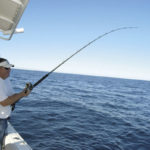
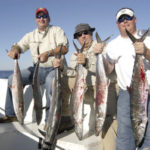
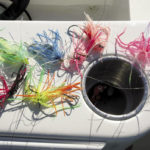
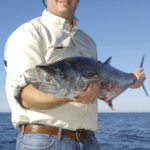
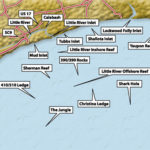



Be the first to comment